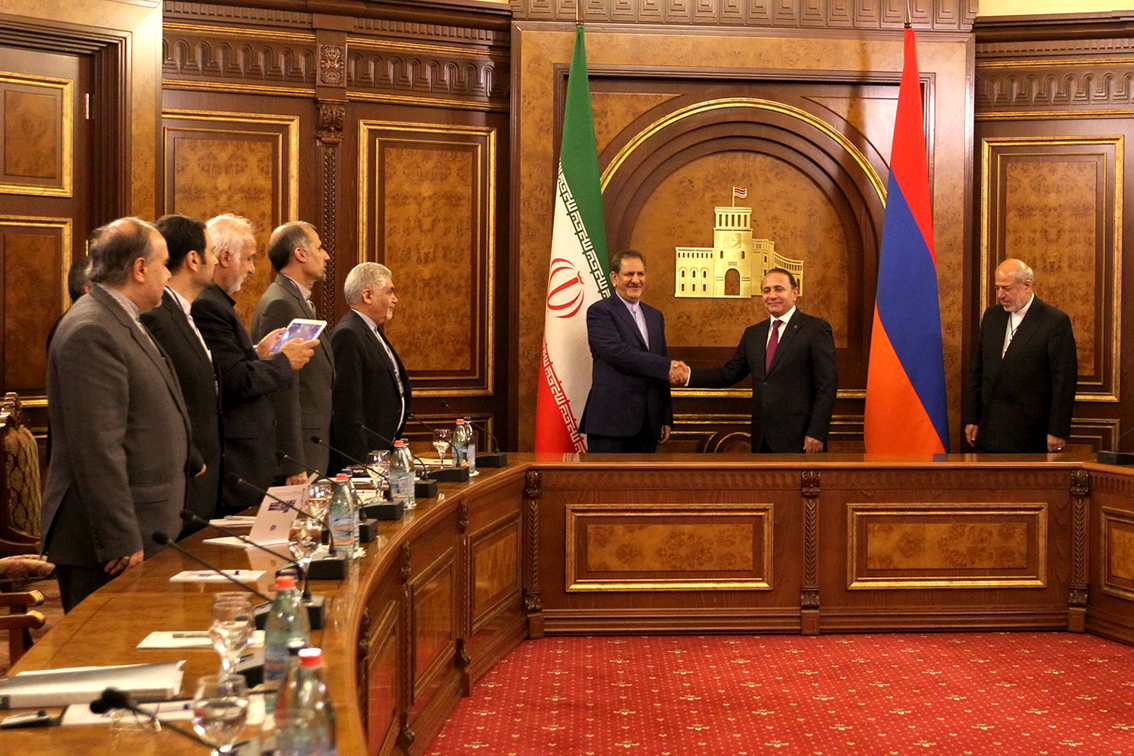Ever since the fall of the Soviet Union, which led to Armenia’s independence, Tehran and Yerevan have enjoyed close political and cultural ties.
Nevertheless, according to First Vice President Es’haq Jahangiri, despite the good political relations, trade and economic relations have lagged behind.
Although both countries have repeatedly shown interest in boosting bilateral trade, the figure has never exceeded $300 million a year. In mid-October, however, Jahangiri traveled to Armenia to turn the tide and set a $1 billion trade target.
The two-day visit, during which he was accompanied by Minister of Roads and Urban Development Abbas Akhoundi, Energy Minister Hamid Chitchian and the head of Iran’s Cultural Heritage, Handicrafts and Tourism Organization Masoud Soltanifar, was aimed at facilitating the implementation of joint projects postponed due to financial issues, the Persian weekly magazine Tejarat-e Farda quoted Iran’s Ambassador to Armenia Seyyed Kazem Sajjadi as saying.
The construction of a third electrical transmission line between Iran and Armenia is one of those projects. Back in August, the two sides signed a $120 million contract to implement the project, but it all came to a halt amid financing problems.
In 2004, Tehran signed a 20-year contract with Yerevan to export gas to its northern neighbor. Based on the agreement, Iran’s natural gas is used by Armenian power plants to generate electricity and, in return, Armenia exports electricity to Iran. The cross-border gas pipeline was commissioned in 2007 and exports began in mid-2009.
The two already operational lines are working at full capacity, producing 300 megawatts of electricity. Yerevan is keen to develop the third line to increase gas exports from Iran.
The power transmission lines play a pivotal role in boosting bilateral trade by increasing electricity import from Armenia in exchange for Iran’s gas export.
“Issues associated with the third phase of the [power transmission] project have been resolved and the implementation of the project has resumed. The project will shore up economic ties between the two neighboring countries,” Jahangiri said in a business forum in Yerevan.
Based on the estimates of Armenian Energy Minister Yervand Zakharyan, the construction of the third phase, which consists of two 220 kWh power transmission lines, will be completed by 2018.
Political issues between Armenia and its eastern oil-rich neighbor Azerbaijan, on the one hand, and Yerevan’s political standoff with its eastern neighbor Turkey on the other have left Armenia with no choice but to import gas either from Russia through Georgia or from Iran.
Iran and Armenia are also planning to develop two major transportation projects: Armenia’s North-South Road Corridor and Armenia-Iran Railroad.
The North-South Road Corridor is a major infrastructure project aimed at connecting Armenia’s southern border with its northern point by means of a 556-km-long Meghri-Yerevan-Bavra Highway.
The Armenia-Iran Railroad is also an ongoing project that seeks to connect the two countries through Armenia’s mountainous Syunik Province bordering Iran, thereby creating the shortest transit corridor from the ports of Black Sea to the ports of Persian Gulf.
The importance of Armenia-Iran Railroad, according to Jahangiri, goes beyond bilateral relations, as they have regional significance.
Jahangiri said Armenia’s land borders with Iran make it a gateway to Eurasian and European markets for Iranian goods and give Iranian producers the opportunity to complete part of the production chain in Armenia and distribute their goods throughout the Eurasian Economic Union.
The EEU is an economic union of former Soviet republics led by Russia to guarantee free transit of goods, services, capital and workers among member states. Besides Russia, other members include Armenia, Belarus, Kazakhstan and Kyrgyzstan.
Leon Aharoniyan, the head of Iran-Armenia Chamber of Commerce, said since there are no tariff barriers to trade between the EEU states, Iran can ship a portion of its semi-finished products to Armenia so that the production chain is completed there, from which point they could be reexported to other Eurasian states.
“This way, Iranian products can be sold in a third country at lower prices, which provide a competitive advantage for Iranian goods in those nations,” he said.
The Iranian government, Aharoniyan believes, should take advantage of the manufacturing capacities of Armenia, as it has inherited many factories from the Soviet Union.
“Although Armenia used to account for only 1% of the Soviet Union population, 3% of the union’s products were manufactured in the country,” he says.
According to Aharoniyan, the EU has recently given the green light for importing 6,400 types of commodities with negligible tariff rates from Armenia, Georgia and Azerbaijan.
Yerevan is also in talks with the United States to establish similar trade arrangements with Washington.
Armenia’s trade ties with the European Union and the United States, he says, provides a golden opportunity for Iranian traders to use the country as a pathway to those parts of the world.
“Such collaborations between Iranian traders and those in Armenia could open a new chapter in Tehran-Yerevan economic relations,” he concluded.


